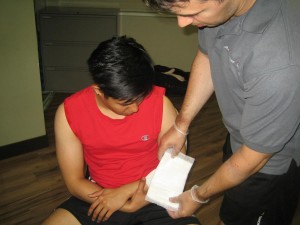Rats are medium-sized with long tails. The “true rats” are members of the genus Rattus. The types of rats that are prevalent in the human world include the black and the brown rat. Rats have large teeth and capable of delivering painful bites when threatened. Rats usually avoid people and like to stay in quite places. If a rat is cornered, they will bite to defend themselves. The saliva of some species of rats carries diseases such as leptospirosis and Hantavirus. An individual bitten by a rat is also susceptible to tetanus infection.
Diseases caused by rat bites
[youtube url=”https://www.youtube.com/watch?v=nHkCx3kyLVM”]- Rat-bite fever – caused by rat bites and scratches. It is an acute human illness caused by bacteria transmitted by rodents, rats or mice that is passed from rodents to human from their urine and mucous secretions. Household pets like dogs and cats that are exposed to these animals can also carry the disease.
- Leptospirosis – a condition that causes kidney and liver damage due to exposure to rat urine. Leptospirosis is caused by bacteria called leptospira found in animals and can spread to humans. An animal carrying the leptospira bacteria shows no signs of illness since the bacteria is just inside the kidney of the infected animal and can pass out of the urine. The bacteria thrive in the soil or water and can survive for several weeks or even months. An individual can also become infected if contaminated water or soil comes in contact with the eyes, mouth, nose and any open cuts in the skin.
- Lymphocytic choriomeningitis (LCVM) – it is a viral infectious disease caused by the saliva and urine of rats. It involves the viral infection of the membranes surrounding the brain and spinal cord as well as the cerebrospinal fluid. There is a high level of lymphocytes during infection.
- Bubonic plague – also known as “Black Plague”. It is caused by the fleas from the rats that bite human beings. Bubonic plague is an infectious disease that is caused by the bacterium Yersinia pestis and it is transmitted to humans from infected rats by the oriental rat flea. The plague causes painfully enlarged lymph nodes in the groin, armpits, neck and elsewhere. Other symptoms include headache, fever, chills and weakness. Bubonic plague can also cause gangrene (tissue death) of the fingers, toes and nose.
- Rat droppings, dander and shed hair can cause people to sneeze and experience allergic reactions.
- Hantavirus – cotton rat or rice rats are the carrier of Hantavirus. Victims can experience difficulty in breathing when they inhale particles from rodent droppings, urine or carcasses that were disturbed.
Treatment of rat bites

- You have to move the individual away from the rat.
- If bleeding, the first aid measure is to stop the flow of blood. Get a piece of gauze or cloth and apply direct pressure to the wound.
- Disinfect the wound by pouring hydrogen peroxide, rubbing alcohol or witch hazel into the wound to remove the dirt and debris. You can perform this if the bleeding has stopped.
- Apply Neosporin to the bite after you have disinfected the area. Continue to apply pressure to the wound if it continues to bleed.
- Cover the cut with a clean pad of gauze and then wrap it tightly with first aid tape.
- Seek medical attention if the bite continues to bleed and if you are not sure of the origin of the rat.
